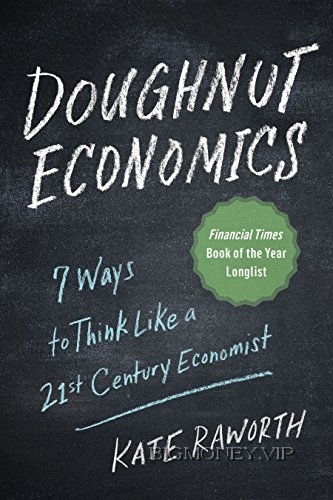
1
CHANGE THE GOAL
from GDP to the Doughnut
Once a year the leaders of the world’s most powerful
countries meet to discuss the global economy. In 2014, for
instance, they met in Brisbane, Australia, where they
discussed global trade, infrastructure, jobs and financial
reform, stroked koalas for the cameras, and then rallied
behind one overriding ambition. ‘G20 leaders pledge to
grow their economies by 2.1%’ trumpeted the global news
headlines – adding that this was more ambitious than the
2.0% that they had initially intended to target.
How did it come to this? The G20’s pledge was announced
just days after the Intergovernmental Panel on Climate
Change warned that the world faces ‘severe, pervasive and
irreversible’ damage from rising greenhouse gas emissions.
But the summit’s Australian host, then Prime Minister Tony
Abbott, had been determined to stop the meeting’s agenda
from being ‘cluttered’ by climate change and other issues
that could distract from his top priority of economic growth,
otherwise known as GDP growth. Measured as the market
value of goods and services produced within a nation’s
borders in a year, GDP (Gross Domestic Product) has long
been used as the leading indicator of economic health. But
in the context of today’s social and ecological crises, how
can this single, narrow metric still command such
international attention?
To any ornithologist, the answer would be obvious: GDP is
a cuckoo in the economic nest. And to understand why you
need to know a thing or two about cuckoos, because they
are wily birds. Rather than raise their own offspring, they
surreptitiously lay their eggs in the unguarded nests of other
birds. The unsuspecting foster parents dutifully incubate the
interloper’s egg along with their own. But the cuckoo chick
hatches early, kicks other eggs and young out of the nest,
then emits rapid calls to mimic a nest full of hungry
offspring. This takeover tactic works: the foster parents
busily feed their oversized tenant as it grows absurdly large,
bulging out of the tiny nest it has occupied. It’s a powerful
warning to other birds: leave your nest unattended and it
may well get hijacked.
It’s a warning to economics too: lose sight of your goals
and something else may well slip into their place. And that’s
exactly what has happened. In the twentieth century,
economics lost the desire to articulate its goals: in their
absence, the economic nest got hijacked by the cuckoo goal
of GDP growth. It is high time for that cuckoo to fly the nest
so that economics can reconnect with the purpose that it
should be serving. So let’s evict that cuckoo and replace it
with a clear goal for twenty-first-century economics, one
that ensures prosperity for all within the means of our
planet. In other words, get into the Doughnut, the sweet
spot for humanity.
How economics lost sight of its goal
Back in Ancient Greece, when Xenophon first came up with
the term economics he described the practice of household
management as an art. Following his lead, Aristotle
distinguished economics from chrematistics , the art of
acquiring wealth – in a distinction that seems to have been
all but lost today. The idea of economics, and even
Doughnut Economics: Seven Ways to Think Like a 21st-Century Economist by Kate Raworth




